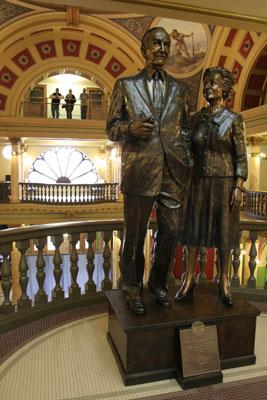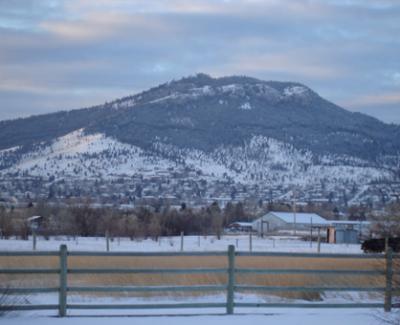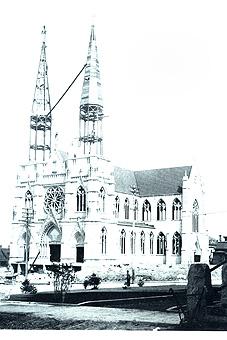Helena: From The Top Down

Helena From the Top Down
article and photos by Jessica Solberg
Mount Helena is one of those “can’t miss” spots for visitors in the capital city. For me, it’s the same, but with the added nostalgia that comes with having grown up here and then returning later in life.
Even if you’re not a serious hiker or mountain biker, the 620-acre park is a must, no matter the season. The 360-degree view from the top is probably the biggest draw, but you don’t have to hike to the summit to get beautiful vistas of the valley, or enjoy the peace and quiet of the woods so close to downtown.

My hiking buddy today is Bailey, a Labrador retriever with a major case of cabin fever, and we’re headed through the timber, whether I like it or not.
In late winter, some folks will try snowshoeing up here. But the trails are typically traveled enough to hike in boots. Aided with YakTrax or MicroSpikes for traction, the slick terrain isn’t so bad.
From the parking lot, there are several straight shots to the top, gradual climbs through the trees, or more level jaunts over the grassy hillsides, all of which offer incredible views.

In the summer, you’re as likely to run into old friends and coworkers on the trail as you are at the local watering holes. Folks either get in a quick hike in the morning before work, hike over their lunch breaks, or hit the trail in the evenings when the air is cooler.
But in winter, things are a bit quieter, and that’s a good thing if you’re looking to get away. No mountain bikers. No high school cross-country runners in training. Just a handful of heavily clothed, eager souls who refuse to wait for the spring thaw.
On Mount Helena, swaths of timber are now gone, victims of the pine beetle epidemic that has plagued much of the Northern Rockies. For the past two summers, crews have worked to remove the “read and dead” trees that dot the mountain and threaten a cataclysmic summer fire under the right conditions.

But today’s jaunt is about tranquility, not fires. A crow caws. Snow drops from a tree in a big clump before bursting into a fine powder. I tug on Bailey’s leash, and we stop to take in the view.
More than a mile above sea level and 1,300 feet above Last Chance Gulch (Helena’s Main Street through Historic Downtown), you can see pretty much everything from up here. There’s the Continental Divide to the west and Canyon Ferry Lake to the east, just beyond the Spokane Mountains.
Below, Spring Meadow Lake is starting to thaw. Next to the park sits the Archie Bray Foundation for Ceramic Arts, a world-renowned residency program for both ceramic masters and artists in training.

The views don’t end there. To the east, the copper dome of the capitol glints in the morning sun, and, nearer, the two spires of the Cathedral of St. Helena stand above the rooftops and leafless trees.
I’ve always been in awe of the cathedral’s spectacular Gothic architecture, and on a quiet day you can sometimes hear the bells from up here. But it’s the way sunlight passes through the 59 stained glass windows that really inspires.
“The inside is the hidden gem,” says Louis Glouge, of the Helena Diocese. “It overtakes you.”
From the Cathedral, I trace the winding route of Last Chance Gulch, one of the city’s most famous reminders of its placer mining days. The stream that ran through what is now downtown Helena—and fed so many miners’ dreams—was diverted underground in the mid-1800s to serve the city’s water supply. Today, the underground river remains. Historians call it the “hidden river of gold.”

Author and interpretive historian Ellen Baumler frequently writes about downtown Helena and its rather colorful history. Her three favorite spots remain Reeder’s Alley, the St. Louis Block, and the Atlas Building.
Reeder’s Alley is the oldest intact Territorial period neighborhood in Helena. Named for brick mason Louis Reeder, the boarding houses were filled with miners who traveled from afar seeking their fortune. On the site is the Pioneer Cabin, the oldest documented dwelling Helena (completed in two separate pieces in 1864 and 1865).
From the 1920s until 1972, the St. Louis Block (near where a restored Helena trolley sits on the Walking Mall) was the site of Dorothy’s Rooms, one of the most famous brothels in the state. According to Baumler, 19 1/2 Last Chance Gulch “probably had the most famous back door in Montana.”

About a hundred yards north sits the Atlas Building. Built in 1889 by the Atlas Company, which sold fire insurance, the structure is topped with stylized flames reaching skyward, two winged salamanders (once used as a symbol for something fire proof).
One could easily spend a day exploring the Gulch, and the same is true about Mount Helena. Seeing so much in one sweeping panorama stirs up memories: there’s my old house, my school, the church where my sister got married.

Up here the crisp air has a way of clearing your head. But Bailey’s had her fill of the hill, and she’s got me in tow, headed back to town.
As we reach the bottom, I see a family sitting at the picnic table, heavy coats shed, basking in the sun. I wave. The father shouts, “We’re ringing in spring!”
Get a Helena walking tour app for your phone>>>http://helena-walking-tours.appsios.net/
Leave a Comment Here
Leave a Comment Here